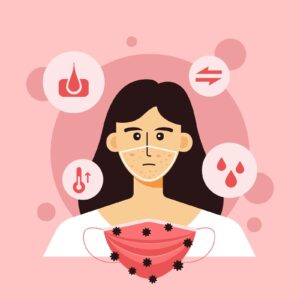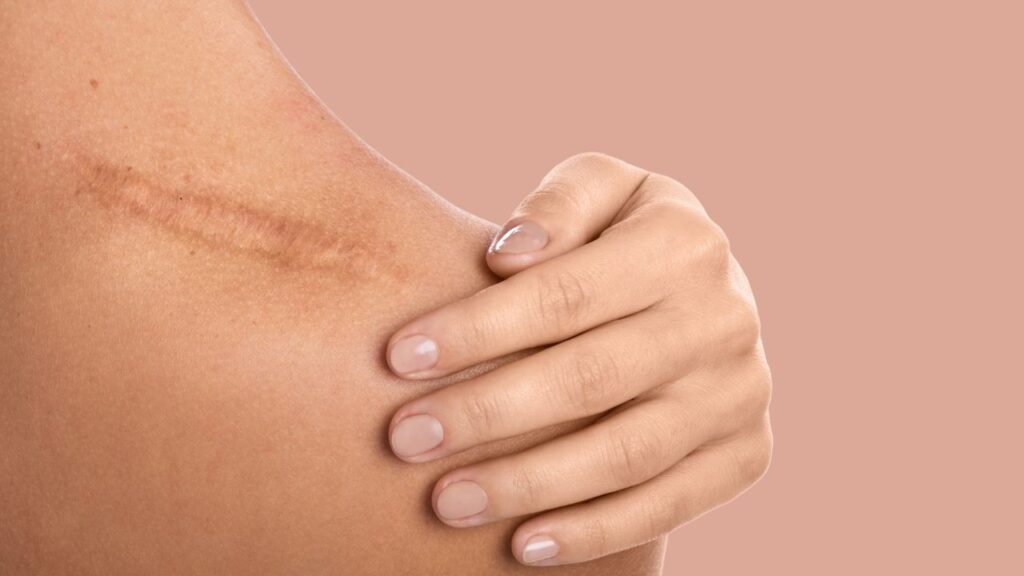Table of Contents
Overview
A sign of infection, chills, fever, and breathlessness are the most common COVID-19 symptoms. However, along with the lungs, coronavirus is also affecting the skin. Yes, you heard it right.
The coronavirus can affect your skin in multiple ways. However, it may be the only symptom of coronavirus infection in some patients.
Let’s know about how coronavirus affects your skin and shows specific symptoms.
What are the 10 ways that coronavirus can affect your skin?
Certain skin symptoms show right after infection, while others show up later or in more serious instances.
Researchers are also trying to figure out what causes these skin diseases, whether the immune system responds to infection or hormones.
From the most common to the least common, below are some effects of Covid on the skin.
1. COVID Toes
According to doctors worldwide, chilblains or covid toes/digits can appear at any age. Some patients who test positive for the coronavirus have discoloured and swollen toes. COVID toes could affect anyone; however, they are more common in children, teenagers, and young adults.
Further, they may notice a brilliant red tint at first, which eventually fades to purple. Moreover, many people never experience other COVID-19 symptoms such as a dry cough, fever, or muscle aches. Also, when they do exhibit COVID-19 symptoms, they are usually modest.
2. Hives
It’s possible to have COVID-19 and get hives. However, according to current reports, a rash normally lasts between 2 to 12 days, with most persons experiencing a rash for 8 days.
When a COVID-19 patient has an urticarial rash, it can appear like:
- Pimples that hurt
- Blisters like chickenpox
- On the skin, there are round, pinpoint dots.
- There is a large patch with multiple smaller patches.
- On the skin, there is a lace-like pattern.
- Flat areas and elevated bumps that connect
3. Small Red Lumps

They seem like flat red spots and are little red bumps all over the body. Maculopapular eruptions have been connected to more serious disorders.
4. Redness of the whites of the eyes
Some patients with coronavirus can experience redness in their eyes.

This type of conjunctivitis is more common as the disease progresses and becomes more severe.
5. Water Blisters
Water blisters are often referred to as vesicular eruptions. They’re microscopic fluid-filled micro-blisters that erupt out of nowhere.
They’re most commonly seen on the hands. Patients in their forties and fifties are at a higher risk. Blisters are a symptom of a moderately severe sickness that lasts about ten days.
6. Fishing Net Rash

It’s known as livedo, a red-blue design that resembles a fishing net. Old age people are more prone to it, including microscopic bruises (purpura). This pattern is caused by blood vessel blockages that happen because of the body’s immune reaction to the virus.
7. Multisystem Inflammatory Syndrome
Youngsters are more prone to this syndrome. This “immune system overdrive” produces inflammation in the heart and blood vessels, resulting in blood clots and shock symptoms. This exceedingly rare negative effect occurs up to three months after receiving COVID-19.
8. Hair loss
Many serious conditions, particularly COVID-19, cause hair loss (telogen effluvium). In moments of stress, the body shuts down superfluous activities. Also, the hair will recover in time if people’s iron levels are normal.
9. Sores
Sores and ulcers can appear in the mouth of a covid patient. However, not all patients face this symptom during the illness. The ulcers settle in two weeks and can be managed by antiseptic mouthwashes.
10. Mask and skin issues
Many people face skin issues sur to the continuous use of masks on their faces. It includes acne caused by the buildup of sweat and oil.

Moreover, the skin temperature rises when the temperature within the mask rises as a result of exhalation. Due to this, skin vessels widen and blood flow increases.
Conclusion
Covid infected people may experience a pale, grey, or blue tint to their skin, lips, or nail beds. Also, if your nail beds have turned blue or grey, seek medical help as soon as possible.
The American Center for Disease Control and Prevention (CDC) reports that people with Covid-19 have a wide range of symptoms besides the core ones.
We should be on the lookout for signs of change in skin tone, as this could indicate a lack of oxygen in the blood. Therefore, according to the World Health Organization, these symptoms are emergency warning indicators, and hence, we should seek medical care immediately.
If you wish to know more about COVID or its symptoms, book an appointment with the best dermatologist today!





